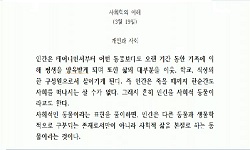This thesis is for the analysis of <Nonggaweollyeongga(농가월녕가)>(=N in followings) by text-linguistic method, specially cohesion and coherence. According to this analysis <N> has the properties as follows : 1) The basic text-unit of ...
http://chineseinput.net/에서 pinyin(병음)방식으로 중국어를 변환할 수 있습니다.
변환된 중국어를 복사하여 사용하시면 됩니다.
- 中文 을 입력하시려면 zhongwen을 입력하시고 space를누르시면됩니다.
- 北京 을 입력하시려면 beijing을 입력하시고 space를 누르시면 됩니다.

<농가월녕가>에 대한 텍스트언어학적 분석 : 텍스트 단위 설정 문제를 중심으로 = Text-linguistic Analysis of <Nonggaweollyeongga>
한글로보기부가정보
다국어 초록 (Multilingual Abstract)
This thesis is for the analysis of <Nonggaweollyeongga(농가월녕가)>(=N in followings) by text-linguistic method, specially cohesion and coherence.
According to this analysis <N> has the properties as follows :
1) The basic text-unit of <N> are lines and a line is composed of two phrase and each phrase have commonly four syllables. In the case of less-four syllbles phrase there is a long sound in a syllable of it and in the case of over-four syllables phrase there is an ellipsis of syllable(s) in it.
2) Most of sentences of <N> are composed of one line. But there are also sentences formed by over two lines and a few sentences made of 5 or 6 lines.
3) Ending '-ni(니)' occurred in <N> is divided into two kind of ending, one is a linking ending meaning 'cause or reason' and the other is a closing ending which means 'representative' and is formed in 'banmal(반말)' type. Therefore the lines which have the latter '-ni' must be counted as a independent sentence.
4) There are cases in <N> in which a line is composed of two sentences. But because these lines can be rewritten to a sentence, these lines must be counted as just a unit for text-linguistic analysis of this text. There are also cases <N> in which sentence begins or closes in the middle of a line. In these cases, they need to be counted as a separate text unit because they are distinguished semantically and syntactically.
5. The integration structure (15) of the begging song of <N> which is resulted from text-linguistic analysis, specially cohesion and coherence show the structure of 'seasonal divisions of nature and human correspondence to it'. This is the same in all the each month's age songs of <N>
목차 (Table of Contents)
- 1. 들어가는 말
- 2. <농가월녕가>의 음보와 텍스트 단위
- 3. <농가월녕가>의 행과 텍스트 단위
- 4. <농가월녕가>의 텍스트 단위 설정의 특이성
- 5. <농가월녕가>의 통합 구조
- 1. 들어가는 말
- 2. <농가월녕가>의 음보와 텍스트 단위
- 3. <농가월녕가>의 행과 텍스트 단위
- 4. <농가월녕가>의 텍스트 단위 설정의 특이성
- 5. <농가월녕가>의 통합 구조
- 6. 나오는 말
동일학술지(권/호) 다른 논문
-
- 국어국문학회
- 심재기
- 2004
- KCI우수등재
-
- 국어국문학회
- 김현자
- 2004
- KCI우수등재
-
- 국어국문학회
- D'Urso, Vincenza
- 2004
- KCI우수등재
-
- 국어국문학회
- 김대행
- 2004
- KCI우수등재




 DBpia
DBpia





